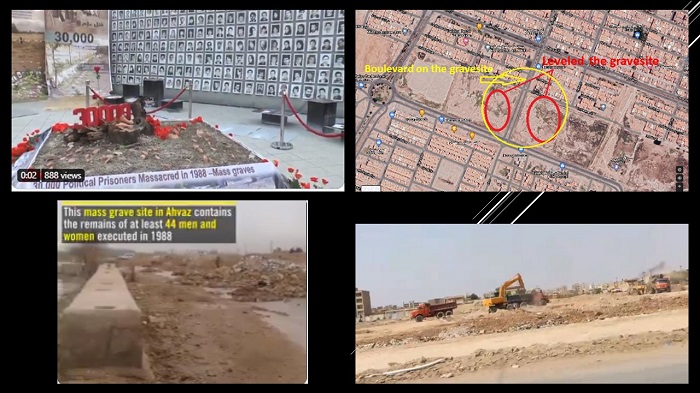

According to the People’s Mojahedin Organization of Iran (PMOI / MEK Iran) last Friday a mass grave in Ahvaz, southwest Iran, was destroyed by the mullahs. These belonged to the many victims of the 1988 massacre and the regime now wants to hide its crimes.
The Iranian regime has tried to cover up its crimes by constructing a boulevard in this place. This has all happened because of the international attention recently focused on the 1988 massacre of political prisoners. This is now classified as the “worst crime against political prisoners since World War II.”
#Iran: Regime builds boulevard over gravesite of massacred PMOI/MEK members in Ahvaz#1988Massacrehttps://t.co/FTg4BBsVmN
— People's Mojahedin Organization of Iran (PMOI/MEK) (@Mojahedineng) September 12, 2020
The MEK within Iran has now completed a documentary video about the mass grave, called ‘Khavaran of Ahvaz’ after MEK supporters thoroughly checked the area. A local truck driver told them where the site could be found.
“Khavaran” are the names of areas throughout Iran where the Iranian regime’s victims, who died in the 1988 massacre, have been buried. In most cases, the graves do not have the names of the victims.
Amnesty International released a report warning about the destruction of the mass graves of the 1988 victims.
This is #Khavaran:#Iran's largest mass grave.The government have buried hundreds of political prisoners here in 1988&buried the truth about the site by bulldozing over it &destroying grave markers&memorials. Watch our short video for more info #BuriedTruthhttps://t.co/etdeegx4RY pic.twitter.com/9Rm6VrMjkx
— Justice for Iran (@Justice4Iran) July 2, 2018
A recent report obtained by the MEK suggests the Iranian regime had deliberately intended to destroy the evidence of their crimes.
Because the international community has remained silent about the 1988 massacre it has meant that the regime has gone ahead with more human rights violations. Iran’s current Judiciary, Chief Ebrahim Raisi, and Justice Minister Alireza Avaei, were both members of the so-called “Death Commissions” which carried out the 1988 executions.
Background to the 1988 executions
In 1988, the Iranian regime without a reasonable trial executed more than 30,000 political prisoners who were held in prisons throughout Iran. The massacre took place due to a fatwa issued by the Leader Ruhollah Khomeini. As it turns out ‘’many of the victims were members and supporters of Iran’s main opposition group, Mujahedin-e Khalq, or MEK. ‘’On August 9, 2016, Hossein-Ali Montazeri’s relative, who was the supposed heir to Khomeini, published an audiotape in which Montazeri can be heard ‘’telling a meeting of members of the “Death Commission” (on August 15, 1988) that they are carrying out a crime against humanity.’’
#Iran must stop the destruction of 1988 mass grave in #Ahvaz #1988Massacre #MEK #UNHumanRights @Asma_Jahangir @nikkihaley pic.twitter.com/YqBojHiPIB
— Iran Freedom (@4FreedominIran) September 4, 2017
Khomeini issued fatwas demanding the execution of anybody who had not “repented” and who was unwilling to cooperate completely with the regime. The massacres started, and hundreds of political prisoners were hanged. Their corpses were quickly buried in mass graves throughout all major cities, in particular Tehran.
Khomeini decreed: “Whoever at any stage continues to belong to the Monafeqin (the regime’s derogatory term to describe the (PMOI / MEK Iran) must be executed. Annihilate the enemies of Islam immediately.” He went on to add: “Those who are in prisons throughout the country and remain steadfast in their support for the (PMOI / MEK Iran) are waging war on God and are condemned to execution.”
Laying flowers at the monument of unmarked graves of the victims of the 1988 massacre in Tehran's Khavaran Cemetery pic.twitter.com/z93CjciM3d
— Maryam Rajavi (@Maryam_Rajavi) September 3, 2016







